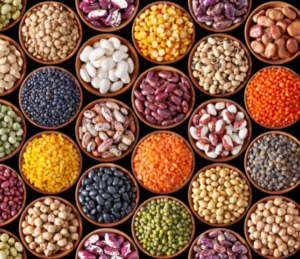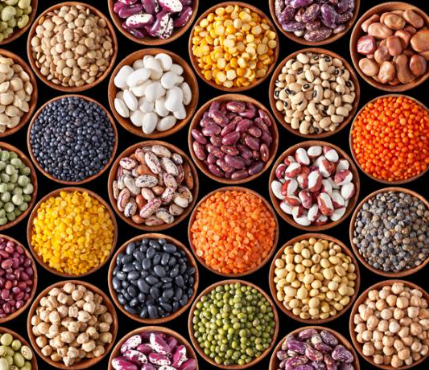Don’t miss beans on the table! Yes, since they represent healthy and creative gastronomy, they recover and maintain the soil for agriculture (according to FAO) and reduce the environmental impact caused by livestock. In addition, growing them is easy and cheap, they provide an alternative to those who do not consume meat, they benefit your body, and they are an economical food available to everyone, among other advantages. Did you know all this? Well, get ready for a new culinary adventure, in which you will learn everything about these legumes and many creative recipes to prepare them that are delicious.
Discover the different types of beans, their characteristics, and benefits and how to cook them. Keep reading!

Legumes are a group of plants belonging to the Fabaceae family (Fabaceae), made up of a wide variety of trees, shrubs, vines and some herbs. These plants share certain characteristics in common, related to appearance, among which their stipulated leaves and pod-shaped fruits stand out. Today, around 19,000 species of Fabaceae or legumes are known, this group of plants being the third with the greatest variety in the world.
Legumes are the fruits of legumes, that is, legumes are plants whose fruits are called legumes. Legumes have a high nutritional value and an important ecological contribution; they have also been part of the human diet since ancient times, approximately since the Neolithic period (the beginning of the human being as a farmer).
Within the group of legumes, beans stand out for their popularity, with around 150 species in the world, of which around 50 are found in Latin America. Within the group of beans are: peas, broad beans, soybeans, mesquites, huaraches, black beans (black beans), among others. So beans are legumes.
Properties and benefits of beans
Bean plants are creeping and climbing herbs, which have a fruit that bears the same name, which grows in an edible pod. The bean, as a fruit, has an outstanding nutritional content, very important for the human body: high protein content, many carbohydrates (good source of energy), high fiber content, and low fat and healthy, many minerals (mainly calcium and iron). ) and vitamins (the vitamin B complex stands out).
Undoubtedly, the nutritional attributes of this legume directly influence the body and the planet, providing incredible benefits, including some still unknown to most, since there are many unfounded myths about beans. Let’s rediscover, then, this food knowing the benefits and properties of beans:
- They help lose weight without deteriorating your health. Although beans contain more than half their weight in starch, which is why they are considered fattening, they have little fat and this is healthy (1.5% to 6.2% lipids) and between 14-33 g of protein per 100 grams of product.
- They benefit diabetic people. Due to its low glycemic index and high nutritional content, it is a perfect food for diabetics despite having a high level of starch and other carbohydrates, since they do not excessively raise glucose (even combined with certain foods).
- They prevent constipation. Thanks to its high fiber content, which contains especially cellulose and hemicellulose, it favors both the digestive tract and generates a low glycemic index.
- They are related to a reduction in the synthesis of fatty acids in the body. This could also be related to a lower concentration of body fat.
- They provide excellent quality protein if you combine them properly with other foods. If you combine legume amino acids (lysine) and cereal protein amino acids (corn or rice), you can compensate for the lack of sulfur amino acids (methionine +cystine) in beans. Thus, you will obtain proteins of high biological value.
- They contain powerful antioxidants from the flavonoid family. In the skin of beans (particularly those with intense or dark tones) there are antioxidants called anthocyanin, which have anticancer, antitumor and anti-inflammatory qualities, among others.
- They contribute to the planet for two reasons: beans are a wonderful food alternative to the high environmental impact caused by highly industrialized livestock farming, and planting beans recovers and maintains poor land (difficult to cultivate), which also favors ecology.
Currently, there are varieties of beans on the verge of extinction due to lack of consumption.
Types of beans and their characteristics
There are mainly three criteria to classify beans: the botanical taxonomic (vegetable taxonomy), the agronomic and the organoleptic (because of their characteristics, especially size and color). The classification based on organoleptic characteristics is more familiar to us, since we use it commonly. This type of classification can vary a bit depending on the country, so it is a bit more difficult to unify. Based on this classification, here are the most popular types of beans that exist:
- Black beans or black beans: these legumes are the most iconic representatives of Latin American food and almost all of these countries sport some traditional recipe with black beans. The appearance of these beans is oval and black with a white dot.
- Anasazi Beans– These types of beans are often prepared refried or as soups. They are characterized by their oval shape, red color and white spots.
- Soybeans: this food is highly appreciated both by gastronomic tradition (in Asia) and by alternative eating styles (vegans and vegetarians) due to its high nutritional content and its versatility in the kitchen. This legume, native to Southwest Asia, is used to prepare sprouts, milk, vegetable meats (it contains vegetable proteins of high biological value), tofu (very nutritious food, excellent for desserts and meals), sauce, oil, flour, fermented foods, etc. Its most outstanding characteristics are its beige color and its almost round shape.
- Pillars beans or green beans: this legume is used in the kitchen, usually to prepare soups and succotash. It has a round, green appearance and a sandy texture.
- Adduce Beans– Also known as auk or Asian beans; they are widely used in Chinese and Japanese cuisine. The adduce are characterized by their oval shape and reddish color.
- Red or common beans: this type of bean is very present in North American (especially Texan) and Mexican cuisine due to its accentuated flavor. They are used for preparations with chili, bean salads, tacos, baked beans, refried beans, among others. This bean is characterized by its Colorado (red) color and its kidney shape.
- Little black beans or proton tape: they stand out in the culinary world for their sweet and smooth flavor, as well as for their creamy but firm body. They are generally widely used in southern cooking. This legume is distinguished mainly by its small size and its black and white color.
- White beans: its most outstanding feature in the culinary world is its ability to easily absorb flavors, which gives it great versatility as a food. They are characterized by being smaller than many other types of beans, white, dry, oval in shape and slightly flattened.
Easy bean recipes
Now that you know the different types of beans there are, taking into account that they are the most used, since we remember that there are more than 150, we are going to see how to cook them. These legumes have incredible culinary versatility; everything consists of the curiosity of each person. Simply review the international, national, naturist cuisine and leave the rest to your creativity. That said; get ready to enjoy dips, soups, stews, salads, purees, rolls, vegetable meats, sweets and a long etcetera. Bon Appetite!




